| Listing 1 - 10 of 19 | << page >> |
Sort by
|
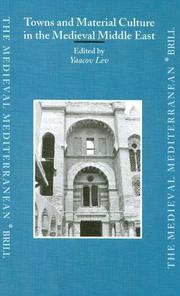
ISSN: 09285520 ISBN: 9004125434 9789004125438 9789004476158 9004476156 Year: 2002 Volume: 39 Publisher: Leiden Brill
Abstract | Keywords | Export | Availability | Bookmark
 Loading...
Loading...Choose an application
- Reference Manager
- EndNote
- RefWorks (Direct export to RefWorks)
This volume focuses on the interplay between urban society and material culture in the medieval and Ottoman Middle East. The history of Jerusalem in the middle ages is discussed by a number of papers as well as Mamluk Tripoli and the urban history of Palestine during the Crusades. The multi-role of the cadi in the Muslim city is illuminated by two studies cases concerning the Fatimid and Mamluk periods. Three aspects of material culture; the production and spread of paper, textiles and the trade in medicinal substances also are dealt with.
History of Asia --- History of Africa --- anno 1200-1799 --- anno 800-1199 --- Middle East --- Cities and towns --- Villes --- History --- Congresses. --- Histoire --- Congrès --- Moyen-Orient --- Social conditions --- Conditions sociales --- Congrès --- Cities and towns, Medieval --- Cities and towns. --- Material culture --- Materiële cultuur. --- Sachkultur. --- Social conditions. --- Stadt. --- Steden. --- Middle East. --- Naher Osten. --- Ramat Gau <1999>. --- Descriptive sociology --- Social history --- Sociology --- Global cities --- Municipalities --- Towns --- Urban areas --- Urban systems --- Human settlements --- Sociology, Urban --- Cities and towns - Middle East - History - Congresses --- Middle East - Social conditions - Congresses --- Middle East - History - Congresses --- Moyen âge
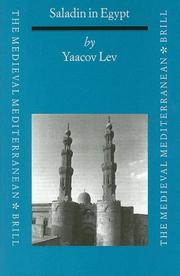
ISSN: 09285520 ISBN: 9004112219 9004476806 9789004112216 9789004476806 Year: 1999 Volume: v. 21 Publisher: Leiden : E.J. Brill,
Abstract | Keywords | Export | Availability | Bookmark
 Loading...
Loading...Choose an application
- Reference Manager
- EndNote
- RefWorks (Direct export to RefWorks)
The rise of Saladin to power in Egypt is a chapter of both Mediterranean and Islamic history. In the period covered by this study, the second half of the twelfth century, profound changes took place in the Eastern Mediterranean affecting the history of the region. The book is divided into two parts. The first deals with the rise of Saladin to power in Egypt (1169-1174) and offers a new interpretation for the demise of the Fatimid state. The second part deals with topics such as the formation of Saladin's army in Egypt, the creation of the navy and the role of the navy in the battle for Acre. The author also addresses topics such as the religious policies of Saladin in Egypt and his attitudes toward the non-Muslim communities.
Saladin --- Egypt --- History --- Saladin, 1171-1193 --- Saladin, --- Saladin, Sultan of Egypt and Syria, 1137-1193
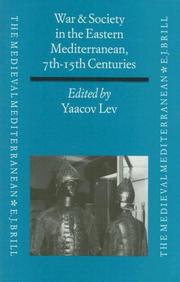
ISBN: 9004100326 9004474471 9789004100329 9789004474475 Year: 1997 Volume: 9. Publisher: Leiden : E.J. Brill,
Abstract | Keywords | Export | Availability | Bookmark
 Loading...
Loading...Choose an application
- Reference Manager
- EndNote
- RefWorks (Direct export to RefWorks)
This volume focusses on the interplay between war and society in the Eastern Mediterranean, in a period which witnessed the Arab conquests, the Seljuk invasion, the Crusades, and the Mongol incursions. The military aspects of these momentous events have not been fully discussed so far. For the first time this book offers a synthesis of trends in military technology and its effect on society in the period from the Arab conquests to the establishment of an Ottoman hegemony. War and Society in the Eastern Mediterranean provides for medievalists an Oriental context to the military aspects of the Crusades, and for scholars of both Middle Eastern and military history a coherent treatment of an important topic over a long period and covering many different cultures.
War and society --- Military art and science --- Guerre et société --- Art et science militaires --- Islamic Empire --- Mediterranean Region --- Empire islamique --- Méditerranée, Région de la --- History, Military. --- History, Military --- History --- Histoire militaire --- Histoire --- Military weapons --- Military history, Medieval. --- Guerre et société --- Méditerranée, Région de la --- History [Military ] --- Mediterranean region --- Military weapons - Islamic Empire. --- Military history, Medieval --- Armaments --- Combat weapons --- Instruments of war --- Munitions --- Military supplies --- Weapons --- Disarmament --- Medieval military history
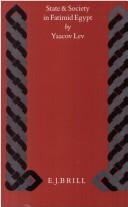
ISSN: Studies ISBN: 9004093443 Year: 1991 Volume: v. 1 Publisher: Leiden : E.J. Brill,
Abstract | Keywords | Export | Availability | Bookmark
 Loading...
Loading...Choose an application
- Reference Manager
- EndNote
- RefWorks (Direct export to RefWorks)
Fatimites --- Caliphs --- Ismailites --- Egypt --- History --- -Fatimites --- Fatimites.
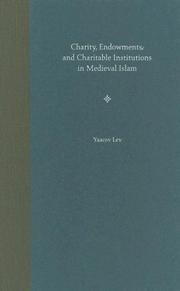
ISBN: 0813035899 9780813035895 0813028698 9780813028699 Year: 2005 Publisher: Gainesville University Press of Florida
Abstract | Keywords | Export | Availability | Bookmark
 Loading...
Loading...Choose an application
- Reference Manager
- EndNote
- RefWorks (Direct export to RefWorks)
In this first comparative treatment of charity and charitable institutions in Islam and Muslim societies of the Middle East, Yaacov Lev mines a variety of primary sources, including Arabic chronicles, dictionaries, waqf (pious endowment) deeds, and epigraphic evidence.
Waqf --- Endowments --- Charitable uses, trusts, and foundations --- Charitable remainder trusts --- Donations --- Charities --- Charity laws and legislation --- Juristic persons --- Trusts and trustees --- Uses (Law) --- Charitable bequests --- Charitable foundations --- Charitable trusts --- Educational endowments --- Endowed charities --- Foundations (Endowments) --- Philanthropy --- Private foundations --- School endowments --- Education and state --- Awqāf --- Evkaf --- Vaqf --- Vkaf --- Wakf --- Islamic law --- History. --- Law and legislation --- History
Book
ISBN: 1474480780 1474459269 1474459234 Year: 2020 Publisher: Edinburgh : Edinburgh University Press,
Abstract | Keywords | Export | Availability | Bookmark
 Loading...
Loading...Choose an application
- Reference Manager
- EndNote
- RefWorks (Direct export to RefWorks)
This book shows how political and administrative forces shaped the way justice was applied in medieval Egypt. It introduces the model that evolved during the 7th to the 9th centuries, which involved 4 judicial institutions: the cadi, the court of complaint, the police/shurta and the Islamized market law.
Justice, Administration of --- History --- Administration of justice --- Law --- Courts --- Law and legislation
Book
ISBN: 9781474459235 9781474459266 1474459269 1474459234 9781474459259 1474459250 Year: 2022 Publisher: Edinburgh
Abstract | Keywords | Export | Availability | Bookmark
 Loading...
Loading...Choose an application
- Reference Manager
- EndNote
- RefWorks (Direct export to RefWorks)
In sum, the book shows that the administrative and political history of the judiciary in medieval Egypt implicitly and explicitly illuminates broader questions about religious and social forces that shaped the lives of medieval people in the Middle East, Muslims and non-Muslims alike.
Justice, Administration of --- Justice, Administration of. --- Law, Medieval. --- History --- Egypt.
Book
Year: 1999 Publisher: Leiden ; Boston (Mass.) : Brill,
Abstract | Keywords | Export | Availability | Bookmark
Book
ISBN: 9789004508774 9789004093447 Year: 1991 Publisher: Leiden; Boston : BRILL
Abstract | Keywords | Export | Availability | Bookmark
 Loading...
Loading...Choose an application
- Reference Manager
- EndNote
- RefWorks (Direct export to RefWorks)
Fatimid history is a chapter of both Mediterranean and Islamic history. In the period covered by the book (10th-12th centuries) profound changes took place in the Eastern Mediterranean affecting the history of the region. Divided into three parts this study deals with the political history of the Fatimid period, the structure of the Fatimid state and the interplay between state and society. The book is a contribution to the study of Islamic military history addressing such topics as: the formation and upkeep of black slave armies, the role of Christian-Armenian troops in twelfth-century Egypt and military and naval aspects of the Fatimid wars with the Crusaders. Other topics examined are the internal policies of the Fatimid state: notably, among them, the religious policies of the Fatimid regime, the involvement of the state in the urban life of the Fatimid capital city, Fustat-Cairo, and Fatimid attitudes toward non-Muslim communities.
Digital
ISBN: 9781474459266 Year: 2020 Publisher: Edinburgh Edinburgh University Press
Abstract | Keywords | Export | Availability | Bookmark
 Loading...
Loading...Choose an application
- Reference Manager
- EndNote
- RefWorks (Direct export to RefWorks)
| Listing 1 - 10 of 19 | << page >> |
Sort by
|

 Search
Search Feedback
Feedback About UniCat
About UniCat  Help
Help News
News